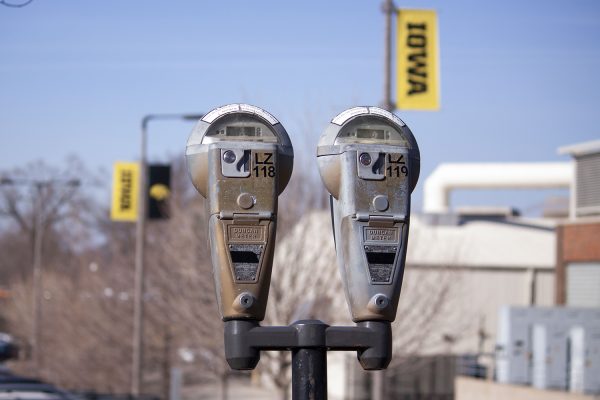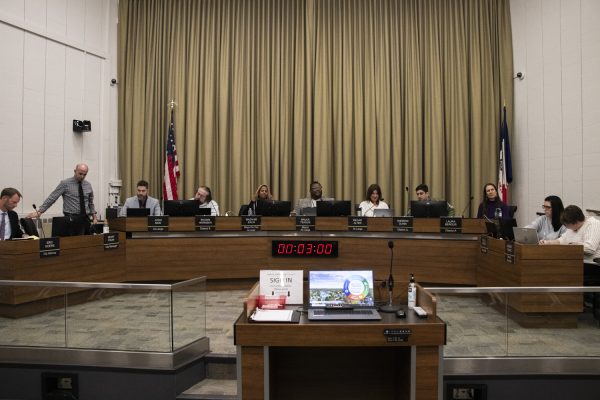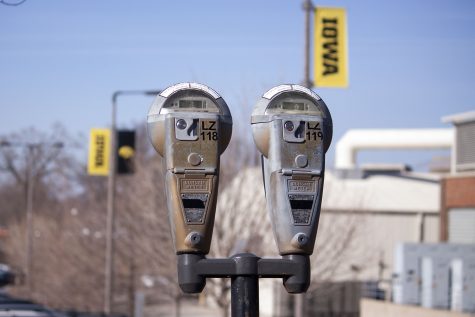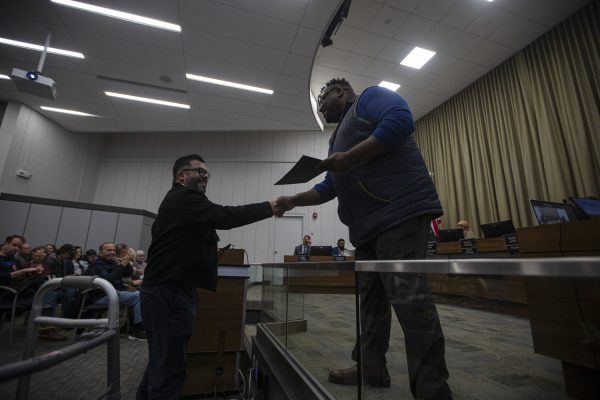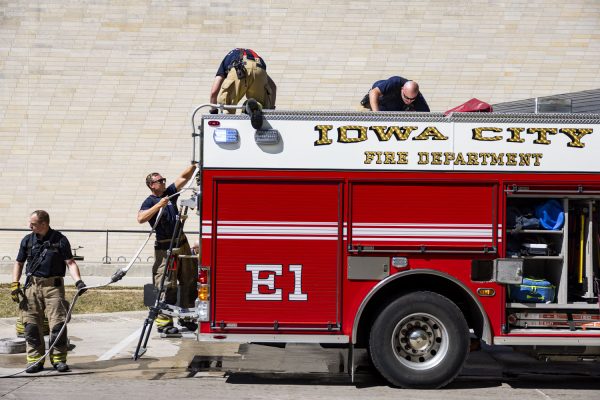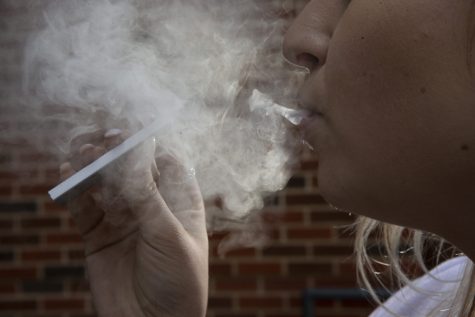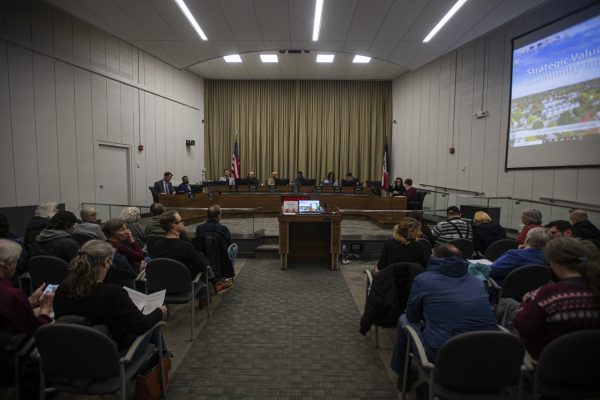IC officials see changes in Burlington Street Dam as unique opportunity for good
The City of Iowa City has been looking at potentially improving the Burlington Street Dam to increase safety and draw visitors to the Iowa River.
The Burlington Street Dam on the Iowa River is seen on Monday Feb. 13, 2023.
Iowa City officials have been eyeing what some consider a “once in a lifetime opportunity” to modify the Burlington Street Dam to draw people to the often-overlooked Iowa River.
While discussions surrounding modifications to the dam are preliminary, City of Iowa City engineer Jason Havel said any changes to the dam would most likely be made during the Burlington Street Bridge replacement project.
Construction of the bridge is slated to begin in 2028, he said.
There have been previous talks about modifying the dam. In 2014, Iowa City City Council hired McLaughlin Whitewater Design Group to determine how much it would cost to build a whitewater rafting course on the Iowa River below the dam. The study the group conducted found that the proposed course would cost too much money and be too difficult to make.
As far as the replacement project for the Burlington Street Bridge goes, the city received a $300,000 grant in October 2022 as a part of the federal Bridge Investment Program to help begin planning for the project.
Map by Jami Martin-Trainor/The Daily Iowan
In an email to The Daily Iowan, Catherine Cutler, an Iowa DOT transportation planner, wrote the Iowa DOT has quarterly meetings with Iowa City’s engineering staff where the bridge project and a planning survey have been topics of discussion.
“We are pleased the city was awarded a grant to perform the study and will be involved with the study as it proceeds,” Cutler wrote. “We look forward to the recommendations from the study. Once the recommendations are known, we will coordinate with the city on a plan forward.”
If anything comes to fruition concerning modifications to the dam, the city will partner with the University of Iowa, which owns the dam, and the Iowa Department of Transportation to move forward with the project, Havel said.
Havel said the city is unsure of exactly what changes will be made to the dam, as the city has not yet had any detailed discussions with the UI or the Iowa DOT.
“I don’t know that it would be complete removal without something else going in because the dam does provide water elevation for water production infrastructure upstream, both for the university and for the City of Iowa City,” Havel said. “I think what we would look at potentially is, are there ways to modify it or come up with another way to meet those needs but also increase safety?”
The city is interested in increasing safety by modifying the dam, Havel said. The Iowa Whitewater Coalition’s website lists drowning as a safety hazard of the Burlington Street Dam and also lists five fatalities that occurred near the dam in the mid to late-1900s.
Most recently, in 2016, Iowa City law enforcement rescued a man from the Iowa River who police said likely went over the Burlington Street Dam.
Potential Iowa River recreational site
If the dam were to be removed, a potential opportunity to arise from this would be the construction of a whitewater park, Havel said. A whitewater park, also known as a river park, is a section of a river that has been designated for recreational activities such as kayaking and fishing.
Larry Weber, the Iowa Flood Center’s IIHR-Hydroscience and Engineering director, said there are whitewater parks across the eastern portion of the state that have seen success from this kind of recreational amenity.
According to the Iowa DNR’s website, several other dams in Iowa — such as dams in Coggon, Mason City, and Manchester — have been removed or modified in the last decade to improve safety, add a recreational site, or improve river conditions for aquatic wildlife.
Ty Graham, a river specialist at Riverwise Engineering, said whitewater parks such as the Manchester Whitewater Park have brought a surge of economic activity to the cities they’re built in. Graham is an avid kayaker himself and has paddled in whitewater play parks across the country.
“[Manchester] ended up building a whitewater park that cost a little over $2 million,” Graham said. “Through visitors and tourism dollars, they have made that money back in the first two years for their whitewater park.”
The excess money made from whitewater parks can also be used by a city to fund costs such as infrastructure improvements like filling potholes, Graham said.
Graham added it is common to see many tourists from out of state visiting these recreational sites, which is beneficial on a local and state-wide level because new money is entering the city’s and state’s economies.
In terms of a potential whitewater park in Iowa City, Graham said the economic impact has the potential to be greater in Iowa City due to its size and vibrant downtown atmosphere.
“If the impact can be that big in a small town … think what we could do in Iowa City,” Graham said. “It’s got all the other ingredients that you need to make this park successful already there.”
Weber added that a whitewater park or some sort of recreational site could be achieved by the construction of a rock ramp.
A rock ramp could also help to improve safety by mitigating drownings caused by getting caught underneath the dam, but it could also create potential flooding issues, Weber said.
“[A rock ramp] also has issues because it provides some flow resistance,” Weber said. “During high flows or flood flows, it would probably raise the water level upstream. If we build a rock ramp downstream, and nobody wants more flooding during high flow conditions, so there’s a little bit of a challenge there.”
Weber said the addition of a recreational site to the Iowa River could create problems with water quality.
“We have our own concerns about water quality issues and how much we want to put people in the water given some concerns with agricultural pollutants, so we’d have to be very careful about that if we wanted to create a recreational facility there,” Weber said.
Complete removal of the dam could also lead to water quality issues because of the sudden release of built-up sediments held by the dam into the rest of the river, Weber said. Because the dam is relatively small this sediment would only cause the water to be dirty for a short period of time, he added.
In 2022, the Iowa DNR found the segment of the Iowa River near the Burlington Street Dam to be “impaired” by pollutants, specifically by E. coli bacteria. The Iowa Department of Natural Resources has an established plan of action to improve the river’s water quality.
While there are no specific dates yet for when this potential project could occur, Havel said if the dam modification is approved, the process leading up to construction is as follows:
- The city will select a consultant for the project, which will help organize the construction process.
- The city will conduct a second study to determine what improvements should be made and what environmental factors need to be considered during construction.
- The project’s actual design and budget will be created and eventually finalized, thus allowing work on the dam to occur during the Burlington Street Bridge replacement project.
Ultimately, dam modifications, especially the addition of a recreational site, could shed a positive light on the Iowa River, Weber said.
“The more we can make the river be an amenity or an attraction to our campus, the better,” Weber said. “This would be another opportunity at potentially getting people excited about our namesake river here.”
Editor's note: the name of the company, Riverwise Engineering, was spelled incorrectly in an earlier version of this article. The Daily Iowan regrets this error.

(she/her)
Isabelle Foland is a second-year student at the University of Iowa majoring in Journalism and Mass Communication and minoring in Spanish. She...




